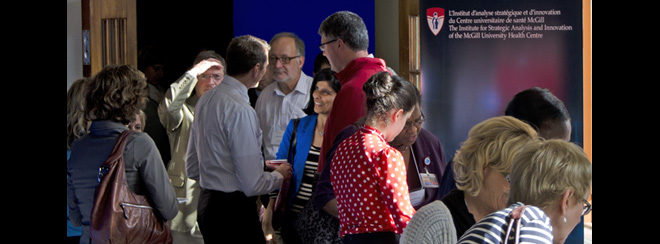2017 conference of the MUHC-ISAI, held October 26-27, 2017, in Montreal
![]()
The conference explored three themes:
1. Network quality from the patient’s perspective
2. Clinical networks to assure and spread practice models
3. Local networks to integrate health and social services
CONFERENCE PROGRAM
Videos and Power Point presentations are now available
Latest from HIF
Patient engagement in clinical research and quality of care
Conference videos and presentations
HOW DOES PATIENT ENGAGEMENT IMPROVE CLINICAL RESEARCH?
The MUHC-ISAI’s 2016 Research SymposiumThis symposium, held in June 2016, was chaired by Vassilios Papadopoulos, Executive Director and Chief Scientific officer, Research Institute of the MUHC, and Jean Bourbeau, Director, McConnell Centre for Innovative Medicine, RI-MUHC. The event introduced two internationally-acclaimed initiatives that are narrowing the distance
 between patient and researcher and have the potential to dramatically accelerate and improve the development and adoption of therapies that respond to patient priorities. Following these presentations, a roundtable discussion among Quebec government, research, patient and industry leaders explored how organizations are engaging patients in the research enterprise and what they see for the future.
between patient and researcher and have the potential to dramatically accelerate and improve the development and adoption of therapies that respond to patient priorities. Following these presentations, a roundtable discussion among Quebec government, research, patient and industry leaders explored how organizations are engaging patients in the research enterprise and what they see for the future.
Featuring:
Peter Margolis and Jennie David, Collaborative Chronic Care Network:
Healthier Together: Collaborative networks of patients, clinicians and researchers to transform chronic illness care
Emil Chiauzzi, PatientsLikeMe:
Crowdsourcing patient medical data: Opportunities and innovationsSEE CONFERENCE VIDEO AND PRESENTATIONS
PARTNERING WITH PATIENTS TO IMPROVE CARE: ESSENTIAL SKILLS AND STRATEGIES
The MUHC-ISAI’s 2015 Annual Conference The conference, chaired by Patricia O’Connor, Senior Advisor, Patient Engagement, MUHC, and special guest co-chair, Angela Coulter, University of Oxford, took place October 30, 2015. This event marked a second opportunity to focus on patient engagement. The 2014 conference provided a broad look at why patient engagement has become a priority. In 2015, we narrowed the focus to look specifically at partnering with patients to design care processes that better meet patient needs. Presenters discussed emerging best practices and strategies to include patients as partners in healthcare improvement.
The conference, chaired by Patricia O’Connor, Senior Advisor, Patient Engagement, MUHC, and special guest co-chair, Angela Coulter, University of Oxford, took place October 30, 2015. This event marked a second opportunity to focus on patient engagement. The 2014 conference provided a broad look at why patient engagement has become a priority. In 2015, we narrowed the focus to look specifically at partnering with patients to design care processes that better meet patient needs. Presenters discussed emerging best practices and strategies to include patients as partners in healthcare improvement.SEE CONFERENCE VIDEO AND PRESENTATIONS
Find out how patient engagement contributes to the innovative capacity of healthcare organizations.
- Hear how clinical teams are partnering with patients to improve care and patient safety.
- Discover best practices in the recruitment and training of patient advisors.
- Learn how to act on patient experience surveys
Report from the 2014 conference
Find out how patient engagement leads to better healthcare solutions
Conference proceedings, case studies and more.
Video highlights
Patients are no longer simple recipients of care. As seen in the short video below, they are advisors on quality improvement, actors in their own care and essential partners in health system redesign.
The MUHC-ISAI conference held in October 2014, in Montreal, assembled over 240 clinicians, patients, managers and decision-makers to explore current manifestations of patient engagement and how they are changing health care processes and outcomes. Exciting challenges and opportunities lie ahead!
Case studies in patient engagement prepared prior to the 2014 conference offer an in-depth look at three projects undertaken by clinicians, staff and patients at the McGill University Health Centre.
Why does patient engagement matter?
Quotes from the conference
 “The structure of our system, which has become more and more specialized and more divided, can’t really cope with the kinds of morbidity that the population actually has today. It’s not fit for purpose.”
“The structure of our system, which has become more and more specialized and more divided, can’t really cope with the kinds of morbidity that the population actually has today. It’s not fit for purpose.”
— Sholom Glouberman, Patients Canada “As much as healthcare has changed in the last 40 years, some of the residual issues about hierarchy, relationships and professional pride that go beyond the necessity of daily practice into interfering with our ability to really reshape the delivery of care will be broken down if the conversation includes those people who receive care and who are interested in the outcomes and the experience and not the titles of the people who are providing them care.” — Ross Baker, Université de Toronto
“As much as healthcare has changed in the last 40 years, some of the residual issues about hierarchy, relationships and professional pride that go beyond the necessity of daily practice into interfering with our ability to really reshape the delivery of care will be broken down if the conversation includes those people who receive care and who are interested in the outcomes and the experience and not the titles of the people who are providing them care.” — Ross Baker, Université de Toronto “In one year, a patient with a chronic disease and his family will spend five to 10 hours with their health professionals, and 6000 hours taking care of themselves. The focus of our system today is on the five to 10 hours and not much on the other 6000. Our patient and family advisors in the Faculty of Health Sciences put forth a vision where the patient is not just at the centre of care but is part of the care team, and is considered an actor of care.” — Vincent Dumez, Université de Montréal
“In one year, a patient with a chronic disease and his family will spend five to 10 hours with their health professionals, and 6000 hours taking care of themselves. The focus of our system today is on the five to 10 hours and not much on the other 6000. Our patient and family advisors in the Faculty of Health Sciences put forth a vision where the patient is not just at the centre of care but is part of the care team, and is considered an actor of care.” — Vincent Dumez, Université de Montréal





